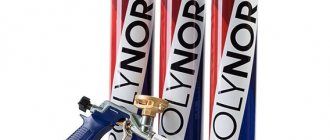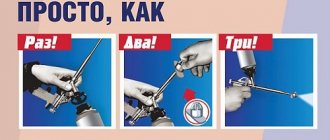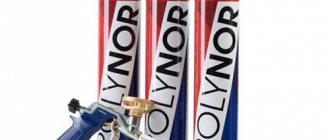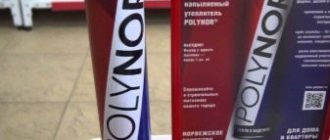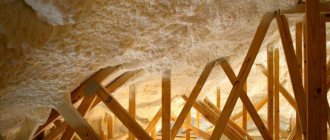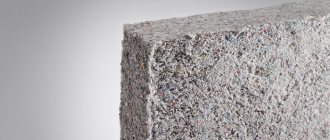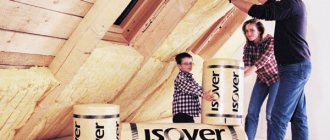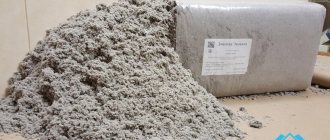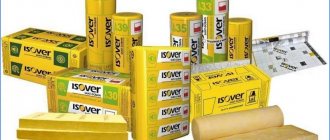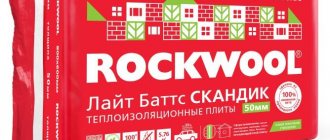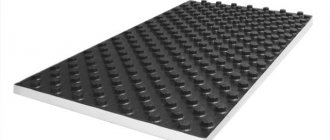Sprayed insulation Polynor
“There is no bad thermal insulation, there is only its incorrect use...”
Hello, dear visitors of my blog!
Today we will talk about insulation, namely polyurethane foam of the Polinor brand. The process of applying a warm layer using the spraying method is unusual. However, it is practical and useful, since it makes it possible to independently “adjust” the thickness of the insulating layer according to need. And also, it does not require special equipment to perform the work, as in this case. So, our topic is polynor sprayed insulation: characteristics and capabilities of the material.
First it's official. Seamless insulation Polynor (in Russian - Polinor) is a one-component polyurethane foam that is applied by spraying. Purpose – surface thermal insulation. The tool used is a mounting gun with a special plastic attachment. The substance itself is contained in disposable cans of standard volume.
Advantages and disadvantages
The growing interest in a new type of heat insulator is dictated by the following advantageous qualities:
• a simple method of insulation that does not require special equipment and skills to work with it; one person can handle the job;
• good adhesion to many building materials;
• high productivity (a 1 m2 area is processed in just 2 minutes);
• low thermal conductivity;
• monolithic surface of the heat-insulating layer, eliminating the formation of cold bridges;
• additional sound insulation;
• ensures that the dew point moves towards the street, which prevents the formation of condensation;
• high resistance to aggressive chemical compounds;
• long service life (the manufacturer declares an operational period of up to 50 years);
• inertness to microbiological processes;
• the material is not interesting to insects and rodents;
• when insulating surfaces, it does not require the creation of an additional windproof and vapor barrier layer.
When using Polinor, it is worth considering the disadvantages of the material:
• poor resistance to ultraviolet radiation;
• nuances when applying a layer to obtain a uniform protective surface;
• compliance with the temperature regime during work (from 15 to 35 degrees plus);
• with prolonged interaction with water, the structure of the insulation is destroyed.
Thermal insulation with polynor - profitable, simple, reliable
The modern consumer is accustomed to the fact that new insulation materials regularly appear on the construction market, and it is difficult to surprise him with anything. Polynor can also be classified as a new product, and nevertheless, it has already taken its rightful place among other insulating materials. Due to its excellent characteristics and ease of use, polynor has received high consumer ratings and also won the title of “people's insulation.” The polynore installation technology is so simple that any beginner can handle it, which is one of the distinctive features of this material. In this review, we will look in detail at the characteristics of the heat insulator, and also tell you how to insulate a house with polynor.
Sprayed insulation POLYNOR
No mechanical fastening of the insulation is required, no frame is needed for its installation, and no special tool is needed for application.
3. High-quality insulation of hard-to-reach places is possible.
4. POLINOR has excellent adhesion to almost all known building materials (metals, wood derivatives, concrete, brick, plaster, glass, plastics) except polyethylene, polypropylene, Teflon and their analogues.
5. It has a practical packaging (890 ml bottle), which is convenient for calculations, transportation and storage.
6. As the next layer, on top of POLYNOR you can use any types of paints, plaster, putty, decorative materials.
7. After polymerization (hardening), it forms a seamless monolithic layer, devoid of cold bridges.
8. Due to the possibility of accurate calculation, after completing the work, there is no excess material left.
9. In Russia and in the world there are no analogues of POLYNOR on the market.
10. Polyurethane insulation has become affordable (affordable) for the average consumer.
11. For the first time, anyone without special skills can use polyurethane foam insulation.
12. Ability to use the product Sprayed polyurethane insulation POLYNOR in places where there is no electricity, and without additional bulky equipment.
13. Transportation and storage of insulation POLYNOR sprayed polyurethane insulation deserves special mention: now there is no need to transport a huge volume of insulation (polystyrene, mineral wool, etc.) to the place of use, because the insulation POLYNOR sprayed polyurethane insulation before application is a liquid polyurethane prepolymer 1 kg = 1 l, which is equivalent to polyurethane insulation of 1.15 m2 with a thickness of 40-50 mm.
14. Small packaging (1 m2) made it possible to take and use exactly as much insulation as you need to use at the site. No excess material remains after insulation.
15. Thanks to the mechanism of PUF formation by interaction of water (air) with NCO, carbon dioxide is formed in polyurethane bubbles, which has one of the lowest Thermal Conductivity coefficients of 0.014 W/m*K at 0C, which makes it possible to actually achieve thermal conductivity of the product of 0.023 W/m* K (Conclusion of the Scientific Research Institute MOSSTROY), which today is not comparable with any insulation available to the average consumer.
Using POLINOR.
Using POLYNOR insulation is no more difficult than working with polyurethane foam and much easier than working with any other insulation.
NPU POLYNOR is a new insulation material that has no analogues on the Russian market, unique in its combination of characteristics and consumer qualities. With its help, you can solve the most complex problems of thermal insulation of your living quarters or the whole house.
The instructions for use are simple and follow just a few simple steps:
Clean working surfaces from dust, dirt and oil stains. The container should be at room temperature (18-35°C) before work. Shake the container thoroughly. Place the special attachment (included in the kit) on the gun barrel until it clicks. Remove the cap from the cross and screw it on gun (not included) onto a vertically standing cylinder. Dispense the output by pressing the trigger of the gun. The spray layer should be no thicker than 5 cm. During operation, periodically shake the cylinder with the gun (while holding the cylinder, not the gun). To clean the gun and remove contaminants from the insulation, immediately after completing work and disconnecting the cylinder, use a special cleaning liquid POLYNOR Cleaner .Hardened NPU is removed using a cleaner for hardened foam POLYNOR Cleaner or mechanically.
IMPORTANT!
The attachment does NOT fit all mounting guns!!!
The nozzle must be put on with force and not freely rotate on the gun.
Precautionary measures:
Uncured polyurethane foam irritates the skin, respiratory tract, and eyes. Therefore, during work you need to use protective gloves and goggles, and in case of insufficient ventilation and high concentration of vapors, use a respirator. If insulation gets into your eyes, immediately rinse your eyes with water and consult a doctor. A foaming agent is heavier than air and is a flammable substance. Work in a well-ventilated area. In the work area, you must not smoke or use sources of open flames, sparks, or devices with open heating elements.
The contents of the cylinder are under pressure!
Contains 4,4-diphenylmethane diisocyanate.
DO NOT STORAGE IN DIRECT SUN RAYS OR HEAT THE CYLINDER OVER 50°C!
Hurry to make your home the warmest and most energy efficient with POLYNOR!
Using the attachment
“Polinor” is a sprayed insulation material that is applied with a special plastic spray nozzle. It is attached to the tip of a regular mounting gun, and to do this you need to remove the nozzle from the sprayer, press it against the tip of the gun, then insert it into the spray nozzle until it clicks. The main thing is not to allow too much stress, as this can lead to cracking of the nozzle body. The nozzle cannot be used to work with regular polyurethane foam.
After the insulation has been applied, you can treat it with water using a regular garden sprayer - this will speed up the polymerization and better foaming of the newly created thermal insulation layer.
Economic justification for the use of Polinor
If we compare the costs of laying conventional polyurethane foam and POLYNOR thermal insulation, then many factors speak in favor of the latter.
Firstly, its use can significantly save money on paying for the work of the installation team: this insulation is easily applied independently, and there is no need for knowledge of construction and technical basics.
Based on market prices in 2014, surface treatment with an area of about 100 square meters. it cost about 50 thousand rubles. These costs are similar to the costs of insulating a structure using mineral wool or expanded polystyrene. And if we compare the one-component effective heat insulator POLYNOR with a two-component mixture in the form of polyurethane foam, then the latter will cost almost one and a half times more.
The approximate cost of 1 cylinder of polyurethane sprayer POLYNOR with a volume similar to polyurethane foams is currently approximately 450 rubles. The modern Russian market is saturated with a lot of offers for the sale of Polinor, so you can always find the most acceptable price for yourself and discuss favorable delivery conditions.
Indoor insulation Polinor is packaged in an economical container, which is why purchasing more material than necessary is practically impossible, but there are no problems in re-ordering it. Please note that the standard package contains 12 cylinders with the mixture.
How to soundproof a ceiling?
Noise in an apartment no longer surprises anyone, but it can be minimized using Polynor construction sprayed insulation. Consumer reviews about it are enthusiastic, not only the affordable price and ease of use are noted, but also high levels of noise insulation. What are the benefits of using this particular material? Firstly, it needs to be applied in a very small layer, so your ceilings will hardly lose any height. Secondly, peace and tranquility will finally reign in your home, since the level of noise-absorbing characteristics, as well as due to its high density and elasticity, the material perfectly absorbs all noise.
“Polinor” is an insulation material whose price is good news. When installing it, again, the construction of a frame is not required, since, when it hardens, it forms it itself. And after the foam has hardened, you can treat the surface with plaster or paint. Another important point is that to install this building insulation, you no longer need to call in professionals - you can do the sound insulation yourself!
Precautionary measures
Despite the safety of the Polinor composition, it is recommended to observe the following precautions when performing insulation measures. • When the composition is released from the cylinder, there is an increased concentration of the chemical components of the insulator, which can cause irritation to the mucous membranes of the eyes, respiratory system, and skin
Therefore, work should be carried out in special clothing, safety glasses, a mask or a respirator.
• When the composition is released from the cylinder, there is an increased concentration of the chemical components of the insulator, which can cause irritation of the mucous membranes of the eyes, respiratory organs, and skin. Therefore, work should be carried out in special clothing, safety glasses, a mask or a respirator.
• Do not spray the contents of the cylinder near an open flame. The presence of gas may cause a fire. It is also prohibited to combine installation with smoking cigarettes.
• In the room where thermal protection is installed, you need to open windows and doors to organize good air ventilation.
In general, working with polyurethane foam insulator Polinor, produced in cylinders, is characterized by simplicity and uncomplicated application techniques, which is confirmed by user reviews.
Main characteristics of the material
This type of insulation, produced in Norway, appeared on the Russian market only in 2014, but today it is considered very popular and effective due to the possibility of significant optimization of costs during construction and insulation of structures.
Polynor has a unique polyurethane composition, packaged in cylinders under a pressure of about 6 atmospheres. Contacting oxygen in the air, the one-component substance is activated, as a result of which it hardens and polymerizes on any surface. Convenient nozzles allow you to spray material in the most difficult to reach places.
The main qualitative difference between the frozen Polinor and its analogues is the ratio of open and closed cells. In the polyurethane composition, almost 70% is closed, whereas in conventional polyurethane foam it is only 30%. This is what determines such qualities of Polinor as a low level of thermal conductivity, vapor absorption and immunity to moisture penetration.
In terms of time costs, Polinor is significantly ahead of other mounting foams, because surface treatment of 100 sq. m with a construction team of several people will take on average only about 3.5 hours.
In this case, the configuration of the room does not matter: the mixture can be applied to the farthest corners, to the joints, to any curved and uneven elements.
Purposes of use
What can be insulated with Polinor:
- residential buildings, country houses, outbuildings;
- industrial buildings, workshops, garages;
- baths, balconies and loggias;
- roofing, floors and walls;
- facades, attics, attics and basements;
- communication structures and systems (pipes, tanks, tanks);
- some types of transport (thermos vans, isothermal cars).
Where is it used?
One-component POLYNOR is widely used for heat and sound insulation of the following elements:
- facades;
- loggias;
- terraces and verandas;
- attics and attics;
- basements;
- residential premises - apartments, houses;
- production premises;
- pipeline systems, utilities;
- thermos vans.
Liquid insulation brand POLYNOR
And the most influential parameter of Polinor’s efficiency can be called thermal conductivity.
The ability to prevent heat loss is a key parameter in all types of insulation. But often the characteristics declared by the manufacturer are leveled out in practice due to the type of insulated surface, the method of installing the insulation and side effects. Sprayed Polynor insulation is devoid of such defects due to reliable adhesion to all surfaces and due to the ability to penetrate into the most difficult to reach places and joints of the house structure.
But returning to the advantages of Polinor’s thermal conductivity, you can pay attention to its priority over other types of thermal insulators
| Type of insulation | Unit change | Mineral wool | Expanded polystyrene | Penoizol | Polinor |
| Thermal conductivity index | W/(m*deg.) | 0,045 | 0,033 | 0,06 | 0,023 |
To fully perceive all the advantages of this insulation, its other advantages should be emphasized, including:
- Possibility of self-adjustment of the applied layer
- Economical use due to doing the work yourself
- Excellent water absorption rates (0.03 for polynore versus 0.14 for penoizol, 0.20 for mineral wool and 0.02 for expanded polystyrene)
- Possibility of creating a seamless layer
- Effective indicators of noise insulation properties
- Operational period of insulation. This figure is again a record - only 180-200 minutes to insulate 100 square meters of area of any configuration.
The advantages also include the possibility of insulating different types of buildings with different surface textures, as well as the absence of complex technological equipment.
Why is POLYNOR warmer and more profitable?
Polinor looks more efficient than other materials, including sprayed analogues, due to the low thermal conductivity coefficient and the most rational heat capacity indicators. For these reasons, it retains the temperature better and does not let heat out.
This material is more profitable both in terms of process availability, as well as for budgetary reasons.
Price of Polinor insulation
The amount of costs is one of the significant arguments in choosing an insulating material. And in comparison with other insulation materials, Polynor benefits due to the economical consumption of the structural composition and due to the absence of costs for the purchase of expensive spray equipment.
The recommended retail price for 1 POLYNOR cylinder is from 450 rubles.
To ensure effective insulation performance, a small volume of Polinor is required, which also makes its use economical. In long-term use, savings are achieved by minimizing costs during the heating season.
Users who have encountered this insulation usually give only positive reviews regarding a noticeable improvement in heat retention, reduced heating costs and ease of use of the insulation.
Some of them were dissatisfied with the polymer smell, which in some cases could last for several days.
In general, this insulation for the walls of a wooden house justifies the costs of its use and is rightly called an innovative means of insulation.
Video about Polinor insulation and its advantages
In the video presenting Polynor insulation, its other advantages are noted that are not mentioned in the description of the characteristics. In this video you can see the effectiveness and appearance of the insulated surface.
Sprayed thermal insulation POLYNOR (POLYNOR) is a one-component polyurethane foam insulation. Norwegian development in the field of heat supply. Easy-to-install insulation for all building structures: floors, walls, ceilings, foundations, air ducts... There are no analogues of the product! 890 ml cylinder, enough for 1.2 m2 of insulated surface 5 cm thick! POLINOR is applied using a spray foam gun and a special nozzle.
POLYNOR insulation has a number of unique characteristics that make it stand out among all other insulation materials:
1. The technology for applying POLYNOR is simple and accessible even to a non-professional performer.
"Polinor" for the floor
This spray-on insulation is ideal for indoor comfort. Thanks to proper thermal insulation of floors, you can make the room warmer, while saving on additional heating. Moreover, you can use Polinor yourself - this does not require special knowledge. The peculiarities of its use are that it is sprayed onto an already prepared surface and easily adheres to any material - from brick to wood and plastic.
Polinor received positive reviews as insulation:
- A comfortable room temperature is maintained.
- The low degree of water absorption makes it possible not to install a vapor barrier layer.
- The material promotes good vapor, hydro and noise insulation.
Material characteristics
Polinor is a sprayed liquid insulation based on PPU (polyurethane foam). The material has a closed, medium-porous cellular structure. Polinor is produced in cylinders with a capacity of 890 ml, where 90% of the space is occupied by air. Due to the high air content, the material has exceptional sound-absorbing and heat-insulating properties.
Insulation is carried out by spraying, similar to polyurethane foam. When sprayed, foam insulation forms a dense film on the surface and then polymerizes.
Many people are interested in: is it possible to insulate wooden houses with polynor? Experts believe that the characteristics of the material are excellent for insulating wooden structures.
Properties of polynore
- The thermal conductivity of the material is 0.025 W/(m*K), due to which the insulation has high thermal insulation characteristics.
- It has good sound insulation properties (sound absorption coefficient is 55 dB).
- Practically does not absorb moisture (water absorption coefficient is 1% of volume)
- The material is light weight and low density (from 19 to 25 kg/m3), and does not exert excessive pressure on loaded structures.
- It allows air and water vapor to pass through well (vapor permeability is 0.0045 kg/(m2*hour).
- Withstands temperature range from -25 to +120 degrees.
Advantages
- This technology provides seamless insulation by filling all voids and cracks. The use of polynore eliminates the formation of cold bridges and reduces heat loss to zero.
- The insulation forms a monolithic surface, which eliminates the entry of moisture and the creation of a favorable environment for the development of microorganisms.
- High speed of work and simple installation. To insulate 1 sq.m. the area will take no more than two minutes. One person can spray polyurethane foam insulation.
- Polinor does not require the installation of a frame; the insulation can be used without additional vapor and waterproofing. In this regard, the final price of insulation turns out to be much lower than thermal insulation with mineral wool, the installation of which requires additional costs for materials.
- The insulation has a low consumption; one cylinder is enough to cover 2 m2 of area with a layer of 3 cm. Economical packaging allows you to purchase exactly as much material as is necessary to insulate the required area.
- Polinor has good adhesion to any material.
- The heat insulator is of no interest to bark beetles, rodents and other pests.
- The service life of the insulation is 35-50 years.
Flaws
- Not resistant to UV radiation.
- The material may be destroyed if it comes into constant contact with water.
- Polinor is toxic; when applied, it releases harmful compounds; when working with it, it is necessary to use protective equipment.
- Difficulty in applying a layer of uniform thickness. The result may be uneven insulation.
Where can it be used?
Sprayed insulation is convenient for application to any surface:
- horizontal (floors, ceilings);
- vertical (walls, doors inside and outside the building);
- inclined (roofs, attic ceilings).
Polinor is used for thermal insulation:
- facades of brick, wooden and frame houses;
- foundation, basement and basement premises;
- balconies and loggias;
- internal surfaces made of wood and other building materials;
- communication systems.
In addition to conventional insulation, the manufacturer produces Polynor 3d for thermal insulation of large areas and hard-to-reach areas. It is also suitable for insulating pipelines and structures of complex shape.
Cellar insulation: cheap and high quality
When decorating a house or apartment, we look for high-quality materials that are also economical. One of the materials that meets these requirements is Polinor insulation. The price starts from 400 rubles per spray bottle. That is why it is often used when it is necessary to insulate the cellar. When carrying out this work, the dimensions of the foundation and the height of the base should be taken into account. Most often, polystyrene foam is used to insulate the basement, but it is not easy to work with, so many people prefer the more economical option - Polinor. The distinctive features of its use include:
- There is no need to construct a frame, since the insulation is sprayed directly onto the surface. The material fills all microcracks, thereby ensuring reliable thermal insulation.
- “Polinor” has high thermal conductivity, so it can be applied in a small thickness.
- Simple installation allows you to do the insulation yourself without using special tools.
- “Polinor” does not absorb moisture, therefore it serves as an excellent waterproofing layer.
- After applying the insulating layer, it can be further processed - painted or plastered.
Installation
When using Polinor there is no need to purchase expensive spray equipment. To get started, just put a specialized gun on the cylinder and press the trigger. The mixture has a high spray speed, it can be easily applied to flat surfaces such as walls and floors, and also squeezed onto the ceiling without fear of leakage or falling off.
It is important to note that after the first pull on the trigger, strong pressure is created, as a result of which too much of the spray mixture may come out. To avoid this, it is recommended to make the first descent within an interval of no longer than 1-2 seconds
A good performance quality of Polinor is that the user has the ability to independently regulate the thickness of the applied mixture. With uniform spraying, you can achieve a layer of any size without seams.
There is no need for special surface treatment before applying polyurethane spray; it is enough to simply clean it of visible large contaminants.
Nuances
It is important to apply the mixture after shaking the container. Moreover, it must be at room temperature! It is best to spray the insulator onto a damp surface, which guarantees excellent adhesion
Applying 1 layer is usually not enough, so after it has dried, you should spray a second one so that the total thickness is around 40-50 mm. During operation, the cylinder should be shaken regularly, and at the end of the action, remove the gun and wash it, which makes it possible to use it on new containers with a heat insulator.
If, after the protective layer has dried, any damage or chips are found, they can be easily eliminated by applying a new layer of polyurethane insulator on top of the defective area. To increase fire-fighting properties, the material is treated with a special composition that will provide the surface with flammability class G1.
After applying the material and completely drying, it can be painted or plastered, as well as covered with plasterboard.
POLYNOR is an excellent innovative high-quality material, through the use of which it is possible to achieve effective insulation of structures and reduce heating costs.
Insulation of a house or bathhouse
One of the most reliable and easy-to-use insulation materials is Polinor. Its characteristics as insulation are always positive, which is due to many factors. The use of this material is advisable and profitable because the insulation process can be made competent and efficient, which means you can significantly save on heating costs. When insulating houses, bathhouses and any residential buildings in general, much attention is paid to achieving the following goals:
- preventing drafts indoors,
- insulation of various structures from exposure to cold air,
- protection of buildings from the negative impact of environmental factors.
All these requirements are met by “Polinor” - a modern insulation material that is easy and convenient to work with. Unlike classic polyurethane foam, it is resistant to moisture, does not deform during operation, and allows you to insulate structural elements. Before starting work, you should prepare the surface for them, and then arm yourself with an ordinary household spray bottle. When insulating a bathhouse or a country house, it is necessary that the polyurethane foam insulation be at a certain temperature. This will ensure fast and high-quality polymerization of the surface. Also, when using an aerosol, you should shake the can thoroughly so that the spray is carried out evenly and efficiently.
Compliance with the stages of applying insulation plays an important role. So, first you need to apply the first layer to the surface - its thickness should not be more than 0.5 cm. There is no need to increase the insulation layer, since it will expand as it hardens. Once the first layer becomes harder, you can apply the second layer. “Polinor” is a unique material because it can be used to conveniently process the most inaccessible places, for example, the corners of apartments and houses. The final layer of insulation is applied to obtain the final thickness, approximately 5-6 cm. Many will say that POLINOR is the same polyurethane foam, but in fact the chemical composition of these materials is significantly different. Accordingly, the technical and operational properties of the material will be different. Due to its plasticity, reliable adhesion of the material to the surface is ensured.
Where to buy Polinor? In any stores that offer construction and finishing materials. Reviews about this Norwegian insulation are mostly good, since it is easy to use and allows you to treat hard-to-reach places. Among the disadvantages, users note a persistent odor that lasts quite a long time; moreover, if a large surface area is processed, too much material will be required, which is not very profitable.
Recommendations for applying insulation
The insulation has all-season use, the main thing is that the temperature of the cylinder during application is within +18 - +35 degrees. At lower or too high temperatures, the insulation loses its properties. Therefore, the cylinder must be kept in a warm room.
The 3D insulation kit comes with two types of attachments: white and blue. The first is intended for spraying on vertical surfaces, the second - on horizontal and inclined surfaces.
After applying the insulation, a dense film forms on the surface within 4 minutes. Complete polymerization occurs within one hour.
20 minutes after spraying, the thermal insulation layer increases by 20%, so the manufacturer does not recommend applying a layer of more than 4 cm at a time. The second layer can be sprayed only after the previous one has completely dried, after about 20 minutes.
Polinor can be applied both under plaster and under cladding with any finishing material. In the first case, the insulation is simply sprayed onto the prepared base. In the second, it is necessary to build a frame of wooden beams in advance, the cells of which are then filled with a heat insulator.
Stages of roof thermal insulation
As you know, any roof consists of several materials:
- Directly roofing material in the form of roofing felt, metal.
- Wooden sheathing.
- Vapor barriers.
- Waterproofing.
Most often, mineral wool or fiberglass is chosen as roof insulation, and this is understandable: they have a breathable structure, good vapor permeability, are resistant to fire and are ventilated. On the other hand, these materials can sag and, accordingly, cold bridges will form. Secondly, due to changes in temperature and humidity, the insulation can collapse and lose all its protective properties.
Installation technology
The process of applying thermal insulation begins with surface preparation: degreasing, cleaning of debris and flaking old building materials. The evenness of the base does not matter and only affects the consumption of Polynor. The insulation has unique adhesion properties, so all non-insulated structures are protected from the penetration of foam; in a frozen state, it is difficult to remove. A nozzle for sprayed thermal insulation is included in the kit; in theory, the thickness of the layer can be controlled without problems, but in practice, uniformity requires experience. No guides, frame or lathing are needed for installation.
The surface is slightly moistened: sprayed polyurethane foam does not like dust. A prerequisite for the technology is the use of PPE: mask, suit and respirator. After the bottle with insulation is screwed on, the nozzle is shaken well and directed to the desired area. The thickness of the spraying is regulated by changing the pressure on the trigger of the construction gun. Upon completion of work, all tools are washed with a special cleaner (Polynor Cleaner).
Several nuances are noted:
- The process of foam formation depends on conditions: air temperature and the absence of wind and dust. During spraying of the material, it is recommended to shake the insulation in the cylinders periodically.
- The included nozzle must not be used for installing regular construction foam.
- The average polymerization speed is 40 minutes; final hardening requires at least 3 days.
- Polynor sprayed polyurethane insulation requires UV protection and can be painted, plastered or hidden without delay.
- Despite its high resistance to moisture and aggressive environments, this insulation does not have hydrophobic properties; it is not used in areas constantly in contact with the ground. Simply put, Polynor does not require a vapor barrier, but is not suitable for use as a stand-alone waterproofing solution.
Price
| Name | Approximate consumption per 1 m2 with a spray thickness of 4-5 cm, | Spray nozzle Polynor | Price per bottle of insulation, rubles |
| Polynor | 1 bottle (890 ml) | Included | 480 |
The cost of professional services for Polynor spraying is 650 rubles per 1 m2, the savings when applying it yourself are obvious. Construction companies are contacted when there is a need for quick thermal insulation of objects with a large area: cottages, industrial premises, attics, basements, carriages and vehicles. The only way to save money is to purchase sprayed liquid polyurethane foam in bulk from a trusted supplier. It should be remembered that insulation consumption increases when work is carried out in the cold season, the optimal air temperature is above +20°C.
Questions and answers
How much does Polynor cost?
The recommended retail price for 1 POLYNOR cylinder is from 495 rubles.
Discounts are possible when purchasing large quantities. You can get more accurate information from POLYNOR sellers https://www.polynor.ru/ru/sales
Is it difficult for an untrained person to use Polynor?
Nothing like this! Polynor is the simplest and most affordable insulation to use. You don't need to have any special skills to use it. All you need is a regular gun for polyurethane foam and a Polynor nozzle for spraying, supplied with each cylinder (Polynor 3D comes with 2 nozzles - regular and angled for horizontal surfaces).
Is this polyurethane foam?
Despite their external similarity, the products are completely different in purpose, properties and characteristics. Polynor has a low coefficient of water absorption, a predominantly closed-cell structure, does not shrink and remains elastic, adheres completely (without gaps) over the entire application surface. Polyurethane foam cannot be applied to the surface with a wide torch like Polinor; there is no foaming.
How long does one bottle last?
One Polynor cylinder with a layer thickness of 30mm yields up to 2m2 (if you follow the instructions).
In one pass you can apply a layer from 1cm to 4cm, applied in 20-minute increments to the previous one, the number of layers is not limited. The thickness of the layer is adjusted by the speed of application.
We recommend applying it in several layers, first the first layer is 1.5-3cm, then after 20 minutes the second layer is up to 4cm, depending on the desired final insulation thickness, which will correct the shortcomings of the first layer and provide seamless heat/wind protection.
How does Polinor differ from other sprayed insulation materials?
The Polinor formula has been developed and tested for several years. The product itself has been produced since 2014 and during this time there have not been a single complaint. All other “sprayed” insulations are ordinary polyurethane foam, they are characterized by: low foaming, impossibility of application to the roof or ceiling, holes inside the insulation, lack of adhesion (sticking) and the worst thing you don’t see is incomplete adhesion to the surface (dew point in the wall).
Beware of fakes, so as not to get a problem in the form of poor-quality insulation (fungus, mold, freezing, and so on)!
Is it possible to insulate an apartment with Polinor?
Polinor fully complies with the uniform sanitary, epidemiological and hygienic requirements. Allowed for heat and sound insulation of apartments, attics, cottages, verandas, attics, loggias and so on. CERTIFICATES
Eco-friendly? Does it attract rodents and insects?
Absolutely environmentally friendly (biologically inert material), does not react with water, air, cold or heat in the range from - 80 0 C to + 121 0 C. Does not contain freon, formaldehyde and other harmful substances.
Rodents and insects are neutral towards Polinor.
Why is POLYNOR so expensive?
Often the choice begins with the low cost of insulation; the cost of additional materials necessary for proper installation of insulation is often not taken into account when calculating. As a result, the final cost of insulation is much more expensive than the initial cost of the insulation on the store shelf.
In fact, the final cost of insulation with Polinor is at least no more expensive than other types of insulation, which initially have a lower price on the store shelf.
The principle of choosing insulation should not be based on its cost and manufacturer, but on its technical characteristics and taking into account all additional costs. You can see a comparative calculation of the cost of insulation with different types of materials in the COMPARISON section.
What are the advantages over extruded polystyrene foam and mineral wool?
WITH POLYNOR YOU DON'T NEED: - a flat surface; — wind/moisture-proof films; - membranes; — mechanical fasteners; - glue; — cutting out the insulation to the required area; — freight transport; — qualification for installation of insulation; — a large amount for the purchase of a large volume of thermal insulation at once;
Application area
Experts recommend using sprayed material when performing insulation:
• facades of houses, plinths with subsequent cladding with plaster mixture or panels;
• communication and pipeline systems;
• internal walls, partitions;
• roofs, attics, verandas, basements, attics;
• loggias, balconies;
• vehicle tanks, tanks with complex wall shapes;
• metal surfaces.
Polinor is ideal for performing insulation work on frame structures due to its ability to be used in hard-to-reach places. The insulator is also suitable for use in layered masonry. It fills the smallest cracks, leaving no chance for the formation of cold bridges.
The high adhesive properties make it possible to apply thermal protection to different types of surfaces (wood, metal, concrete, etc.). Polinor is suitable for external and internal work, which is explained by its resistance to temperature changes and sub-zero temperatures.
We insulate the roof
“Polinor” is a universal material with which you can perform a whole range of insulation work in the house. As for the arrangement of the roof, experts advise paying close attention to this process and not choosing too cheap materials. However, many modern builders prefer materials such as Polinor. Its price is affordable, but in terms of surface quality it is not inferior to expensive analogues. In order for the roof insulation to be carried out correctly, the order of work must be followed.
Properties
The main goal of Polinor is to effectively insulate a structure from noise and maintain the required temperature in it.
Being a high-class sprayed insulation, the material has the lowest thermal conductivity among analogues presented on the domestic market. So, if mineral wool has a heat saving of 0.045 W/m*deg, penoizol - 0.06, and polystyrene foam - 0.033, then for POLYNOR this figure is 0.023 W/m*deg.
In addition, POLYNOR does not require additional treatment with a protective film and does not require the purchase of accessories for installation.
Advantages
Polyurethane material has the following obvious advantages:
- High degree of adhesion to building surfaces of various qualities (possibility of using Polinor in combination with any popular building materials: brick, plastic, stone, concrete, wood).
- Reduced ability of the material to ignite.
- Low labor intensity, simplicity and ease of installation (no additional frames or special skills required).
- Environmental friendliness and low degree of toxicity of the mixture (after complete drying it does not emit substances harmful to human health into the atmosphere).
- Durability (official warranty from the manufacturer is 45 years, while the insulator serves without crumbling or sagging).
- The material, due to its lightness and airiness, does not create additional load on the frame and load-bearing elements of the building.
- The elasticity of the mixture makes it resistant to cracking and any mechanical vibrations during the repair process.
This sprayed insulation is biologically passive, that is, it does not attract rodents and is significantly resistant to the appearance of fungi, mold and other harmful microorganisms on the treated surface.
One-component sprayed polyurethane foam system Polynor (POLYNOR) in aerosol cans
Thanks to the emergence of innovative materials on the construction and finishing works market, processes are being optimized, the quality of construction is improving, and construction time is being reduced. Such technological innovations include Polynor, the insulation of the future, which is fundamentally different from traditional materials and technologies for insulating buildings. Manufacturer Norway.
Most people are wary, even hostile, towards innovation. The first issue is cost. Price, of course, is important, however, first you need to understand the essence. What are the technical characteristics, composition, what is the system of application of the new product.
The main differences of the new insulation are:
- an application method that does not require complex installation, special equipment and tools;
- ease of operation - does not require special knowledge and skills;
- purpose - from insulating walls to effectively sealing cracks;
- simplified ability to regulate the layer.
Did you know that: polynor is a sprayed insulation, one-component polyurethane foam. Designed for effective insulation of surfaces using a seamless method.
It is applied by spraying using a mounting gun. Polinor is sold in disposable cylinders with a pressure of 6 atmospheres of standard volume.
The new product increases the thermal protection of a building significantly, and is especially useful for owners of private houses for eliminating cracks in different places in the building. Polinor is a foam material with a bright orange-pink color.
Application
The purpose or purpose of creating polyurethane foam is thermal insulation, noise insulation, sound insulation. The new polyurethane foam insulation is a high-class heat-protective material.
Having the lowest thermal conductivity among analogues (0.023 W/m*deg), the sprayed material does not require additional treatments or protective films.
Its use does not require mounting and other accessories necessary for the installation of other insulation materials.
Expert advice: try polyurethane insulation in practice to understand how justified its high heat-protective characteristics are and how rational its consumption is.
Please note that high thermal protection characteristics mean low thermal conductivity and the ability to regulate flow, which makes the use of Polinor economical and profitable.
PPU is used for insulation:
- premises walls;
- roofs;
- gender;
- ceiling;
- basement;
- plinth inside and out;
- foundation;
- pipes and pipelines;
- separate rooms, balconies, verandas;
- industrial buildings, workshops, chambers;
- vehicles, trailers, tanks, wagons, vans;
- garages;
- utility rooms.
It is difficult to list where this heat-protective liquid insulation applied by spraying is applicable.
Advantages
The recently introduced insulation is rapidly gaining popularity. Its use not only increases the quality of construction of buildings and structures, but also contributes to significant cost optimization.
Polyurethane, interacting with oxygen, is activated and hardens. The same thing happens when polyurethane foam is used. However, the difference is significant.
Take note: the main difference between Polynor insulation and analogues and foam is the number of closed cells. Frozen Polinor is 70% of the cells closed, while foam and other materials cover only 30%.
In addition, with the help of aerosol cans attached to a gun, hard-to-reach places are insulated and the access of cold air to the smallest cracks is blocked.
In addition to low thermal conductivity, the obvious advantages of Polinor are as follows:
- high degree of adhesion, it can be used to insulate absolutely any surface, brick, concrete, stone, wood, plastic, etc.;
- low flammability with attenuation properties;
- easy simple installation;
- durability, strength, reliability;
- lightness, does not weigh down the structure;
- environmental friendliness;
- inertness to mold, fungi, rodents.
It is impossible not to notice that the material is conveniently packaged, economical to use, and can be purchased in the required volume.
There is no need for a frame, as for mineral wool and other roll or sheet insulation; labor productivity with Polynor doubles.
Flaws
There are no ideal materials; Polinor requires caution during the application process. During the polymerization process that occurs during spraying, toxins are released that are harmful to the human body. These chemical compounds lose their toxicity after final hardening, although the smell persists for some time.
Please note: work with Polinor must be carried out in protective equipment, a respirator, glasses, and gloves. Provide ventilation and take breaks to rest.
Tags: balloon, sprayed, polynor, insulation
« Previous entry
